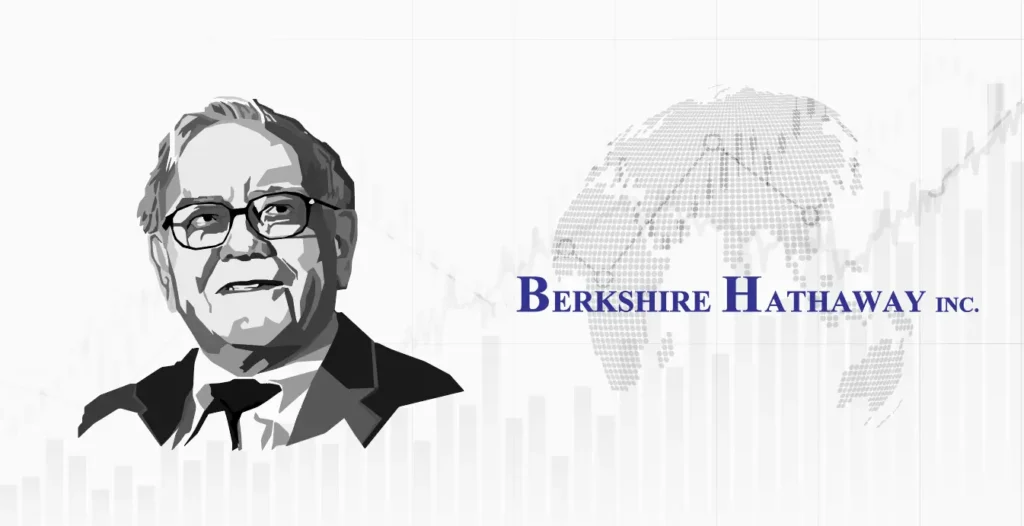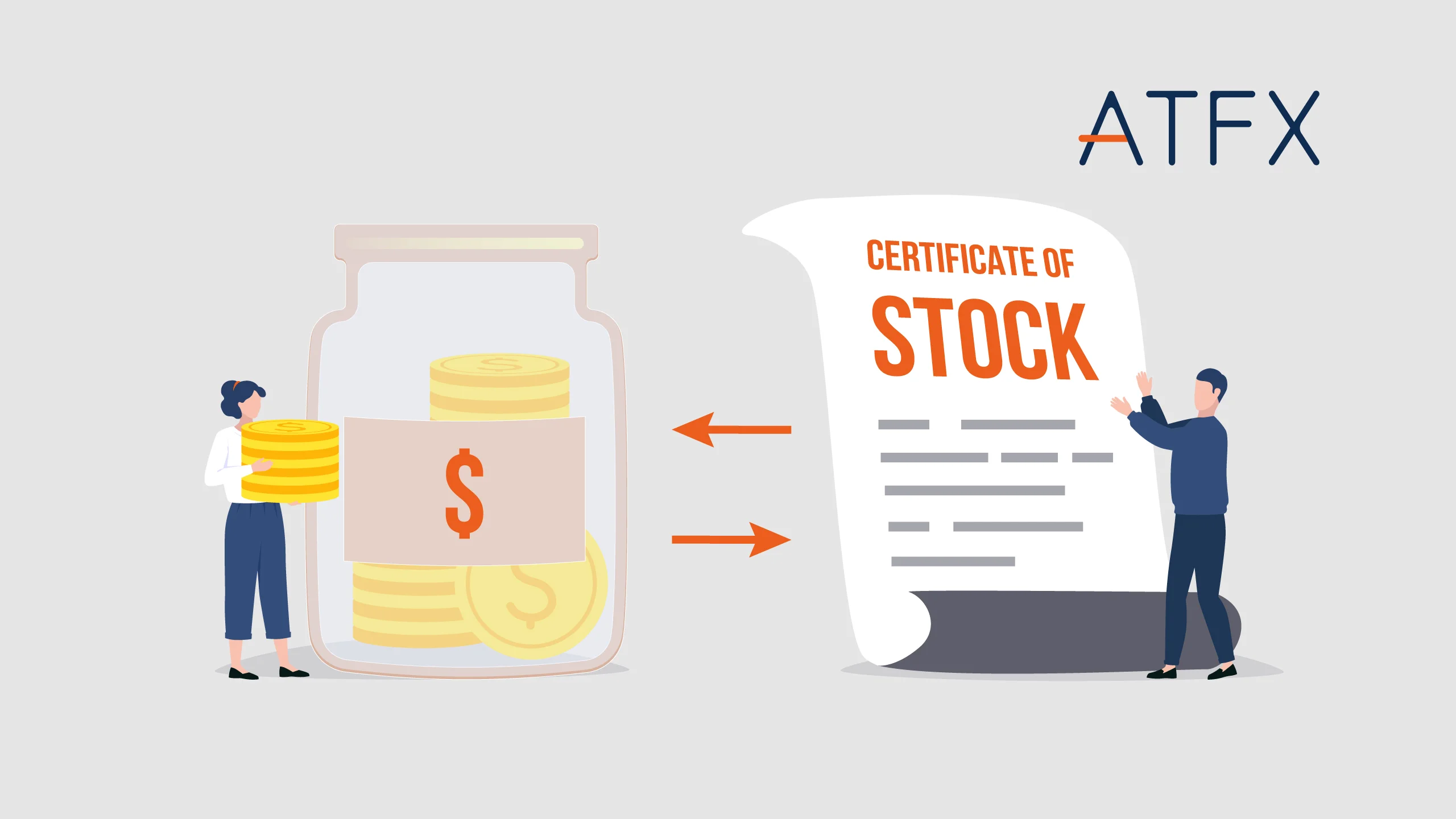Table of contents:
- Top 10 Warren Buffett Stocks Portfolio List 2025
- What is Berkshire Hathaway?
- Who is Warren Buffett?
- History of Berkshire Hathaway
- Class A (BRK.A) & B Share (BRK.B)
- Berkshire Hathaway Portfolio Companies List 2025
- Is Berkshire Hathaway a Good Stock to Buy in 2025?
- Steps to Trade Warren Buffett’s Top Shares
Top 10 Warren Buffett Stocks Portfolio List 2025
- Apple Inc. (AAPL)
- Bank of America Corp. (BAC)
- American Express Co. (AXP)
- Coca-Cola Co. (KO)
- Chevron Corp. (CVX)
- Occidental Petroleum Corp. (OXY)
- Kraft Heinz Co. (KHC)
- Moody’s Corporation (MCO)
- Chubb Ltd. (CB)
- DaVita Inc. (DVA)
What is Berkshire Hathaway?
Berkshire Hathaway is a multinational conglomerate led by Warren Buffett. It invests in various industries, including insurance, utilities, railroads, and manufacturing. Berkshire Hathaway’s market value is estimated to be $1.05 trillion in 2025, making it one of the world’s most valuable firms.
In 2025, Warren Buffett focused Berkshire Hathaway’s strategy on integrating artificial intelligence and advanced manufacturing technologies for long-term growth and efficiency. While specific AI investments aren’t detailed, the emphasis reflects a proactive approach to emerging trends. For example, Berkshire Hathaway Energy is investing $3.9 billion in the Wind PRIME project in Iowa and exploring battery storage solutions, such as the Glacier Battery System, in Montana. This move demonstrates that Berkshire is adapting to both technological advancements and sustainability to ensure future growth.
Who is Warren Buffett?

Warren Buffett, known as the “Oracle of Omaha,” is one of the most successful investors in history. He became CEO of Berkshire Hathaway in 1965, and the company has since developed into a global powerhouse. Buffett is well-known for his value investing strategies and long-term market view.
When people talk about Warren Buffett’s share portfolio, they usually mean the publicly traded stocks in Berkshire Hathaway’s investment portfolio, which is chosen and managed by Buffett and his team. However, this may not include Berkshire Hathaway’s other investments, including privately held companies and significant minority stakes in publicly traded companies.
History of Berkshire Hathaway:
Berkshire Hathaway began as a textile company in the 19th century. Warren Buffett acquired it in the 1960s and transformed it into a holding company with stakes in diverse industries, including Geico, BNSF Railway, and Dairy Queen.
As of 2025, Warren Buffett and large institutional investors like Vanguard, BlackRock, and State Street Corporation hold most of Berkshire’s shares. The Bill & Melinda Gates Foundation also holds notable shares due to Buffett’s contributions. The ownership is rounded out by individual investors, from small shareholders to high-net-worth individuals.
Charlie Munger, Buffett’s longtime partner, passed away in 2023. His estate or trust may still hold his shares, which are managed according to his estate plan. This plan could involve distributing the shares to his heirs, transferring them to trusts, or making charitable donations.
Class A (BRK.A) & B Share (BRK.B)
Berkshire Hathaway offers two categories of shares: Class A (BRK.A) and Class B (BRK.B), designed to accommodate different types of investors and provide greater flexibility in stock ownership. They not only serve large institutional investors and smaller retail investors, but also strike a balance between accessibility and maintaining a stable, long-term investment base.
Class A Shares (BRK.A): These initial shares constitute a greater investment in the corporation. They are expensive and primarily intended for institutional investors and high-net-worth individuals. In early 2025, each Class A share was valued at more than $700,000.
Class B Shares (BRK.B): These were introduced in 1996 to make Berkshire Hathaway more accessible to small investors. Each Class B share is 1/1,500th of a Class A share and substantially cheaper. Class B shares were worth more than $400 in early 2025.
Key Differences Between A and B Shares:
- Price: Class A shares are far more costly than Class B shares.
- Voting Rights: Class A shares have stronger voting power (1 vote per share vs 1/10,000th of a vote per B share).
Berkshire Hathaway Portfolio Companies List 2025:

Warren Buffett has carefully curated a diversified portfolio of publicly traded stocks and wholly-owned businesses. Refer to Warren Buffett’s current portfolio as below.
1. Apple Inc. (AAPL):
- Stake Value: ~$58.97 billion
- Percentage of Portfolio: ~ 21.1%
- Shares Owned: ~300 million
- Industry: Technology
Apple is Berkshire Hathaway’s largest holding. Buffett considers Apple more of a consumer products company due to its brand loyalty and customer ecosystem. The investment in Apple has consistently generated significant returns for Berkshire, with dividends contributing billions of dollars annually. He often praises Apple CEO Tim Cook for his exceptional leadership.
2. Bank of America Corp. (BAC):
- Stake Value: ~$28.45 billion
- Percentage of Portfolio: ~10.2%
- Shares Owned: ~631.5 million
- Industry: Financial Services
Bank of America is Buffett’s second-largest holding. Berkshire Hathaway acquired the initial stake during the 2011 financial turmoil through a private deal. Since then, the position has grown substantially, and Berkshire now owns over 10.2% of the bank, making it the largest shareholder. The investment generates significant dividends and is part of Berkshire’s broader focus on banking and financials.
3. American Express Co. (AXP):
- Stake Value: ~$44.94 billion
- Percentage of Portfolio: ~16.1%
- Shares Owned: ~151.6 million
- Industry: Financial Services
American Express is a long-term holding in Berkshire Hathaway’s portfolio. Buffett bought American Express shares in the 1960s, during the “Salad Oil Scandal,” when the stock was heavily undervalued. His unwavering belief in the company’s strong brand and customer loyalty has made it one of the most iconic investments in the portfolio. American Express continues to generate consistent dividends and remains a staple in Berkshire’s financial sector investments.
4. Coca-Cola Co. (KO):
- Stake Value: ~$27.68 billion
- Percentage of Portfolio: ~9.9%
- Shares Owned: ~400 million
- Industry: Consumer Staples
Coca-Cola is another long-term portfolio investment dating back to the late 1980s. Buffett appreciates Coca-Cola’s global brand recognition and pricing power, translating into consistent dividends. Despite changes in consumer preferences and challenges in the beverage industry, Buffett remains a staunch supporter of Coca-Cola’s leadership and strategic direction.
5. Chevron Corp. (CVX):
- Stake Value: ~$17.57 billion
- Percentage of Portfolio: ~6.3%
- Shares Owned: ~ 118.6 million
- Industry: Energy
Chevron has become a substantial asset in Berkshire Hathaway’s portfolio in recent years, with Buffett increasing his stake as oil prices rose. Chevron is part of Buffett’s growing energy portfolio, and the investment delivers significant dividends for Berkshire Hathaway. Despite the volatility in oil prices, Buffett remains optimistic about Chevron’s long-term prospects.
6. Occidental Petroleum Corp. (OXY):
- Stake Value: ~$12.01 billion
- Percentage of Portfolio: ~ 4.3%
- Shares Owned: ~2264.9 million
- Industry: Energy
Berkshire Hathaway became Occidental Petroleum’s largest stakeholder after it acquired Anadarko Petroleum. Berkshire owns more than 20% of the firm, a position it established in 2019. Buffett has expressed confidence in Occidental’s management and business strategy, particularly its focus on low-cost production and fiscal discipline.
7. Kraft Heinz Co. (KHC):
- Stake Value: ~$8.36 billion
- Percentage of Portfolio: ~3%
- Shares Owned: ~325.6 million
- Industry: Consumer Staples
Despite recent struggles in the consumer staples sector, Kraft Heinz remains a substantial portfolio company for Berkshire Hathaway. Berkshire Hathaway and 3G Capital purchased Heinz in 2013 and merged it with Kraft Foods. Although the venture has encountered challenges owing to shifting customer tastes, Buffett remains enthusiastic about the company’s future possibilities.
8. Moody’s Corporation (MCO):
- Stake Value: ~$11.60 billion
- Percentage of Portfolio: ~4.2%
- Shares Owned: ~24.7 million
- Industry: Financial Services
Moody’s Corporation, a leading bond-rating agency alongside Standard & Poor’s, plays a significant role in Berkshire Hathaway’s portfolio due to its consistent profitability and robust market position. Warren Buffett loves Moody’s because of its consistent income streams and critical position in providing financial market credit ratings and research services. Berkshire has generated a substantial profit from the investment, with the initial cost base now representing a small fraction of its current value.
9. Chubb Ltd. (CB):
- Stake Value: ~$7.62 billion
- Percentage of Portfolio: ~2.7%
- Shares Owned: ~27 million
- Industry: Insurance
Warren Buffett’s investment in Chubb Ltd. (CB) has become one of Berkshire Hathaway’s most significant publicly traded holdings, now accounting for approximately 2% of the portfolio. As one of the largest shareholders, this move reflects Buffett’s ongoing interest in the insurance sector, where companies like Chubb benefit from generating “float,” or capital invested before claims are paid. Chubb, the world’s largest publicly traded property and casualty insurer, has a solid track record of disciplined underwriting and risk management, positioning it well to capitalise on rising interest rates. With a history of consistent dividends and share buybacks, Chubb aligns perfectly with Berkshire’s long-term investment strategy, offering both stability and growth potential.
10. DaVita Inc. (DVA):
- Stake Value: ~$4.59 billion
- Percentage of Portfolio: ~1.6%
- Shares Owned: ~33.7 million
- Industry: Healthcare
DaVita Inc. provides Berkshire Hathaway with significant exposure to the healthcare sector, specifically in kidney care and dialysis services, reflecting Buffett’s interest in essential services with consistent demand. Operating a vast network of outpatient centres, DaVita ensures a steady revenue stream and benefits from economies of scale and international expansion. R&D investments improve patient outcomes, while regulatory compliance and strategic partnerships broaden its offerings. Emphasizing community involvement, DaVita supports patients and families, making it a resilient addition to the portfolio.
11. Other Notable Holdings:
- Stake Value: ~ $57.19 billion (total amount)
- Percentage of Portfolio: ~20.3%
- VeriSign Inc. (VRSN): Berkshire owns a notable stake in this internet infrastructure company.
- Visa Inc. (V): Berkshire has a meaningful position in the global payments giant.
Is Berkshire Hathaway a Good Stock to Buy in 2025?
Due to Warren Buffett’s proven track record, Berkshire Hathaway is often regarded as a reliable long-term investment. However, consider the following before investing in top Berkshire Hathaway portfolio companies:
Reasons to Buy:
- Diversified Portfolio: Gain exposure to various sectors through one stock.
- Strong Management: Buffett’s value investing approach has historically generated impressive returns.
- Financial Stability: The company holds significant cash reserves for acquisitions.
Reasons to Reconsider:
- Lower Growth Potential: As a mature company, Berkshire may offer slower growth than smaller companies.
- Dependence on Warren Buffett: At 93, Buffett remains a central figure in the company, raising concerns about future leadership.
Steps to Trade Warren Buffett’s Top Shares
- Research and Analyze: Familiarize yourself with the businesses, financial health, market position, and future prospects of Buffett’s top holdings. This comprehensive understanding aids in making informed investment decisions.
- Select a Brokerage Account: Choose a reputable brokerage platform that offers access to U.S. stock markets and provides robust research tools. A good brokerage should have a user-friendly interface, low fees, and reliable customer support. See also shares CFDs on ATFX, including Hong Kong stock trading and global stock trading.
- Portfolio Diversification: Ensure your portfolio is diversified across different sectors and asset classes, even while focusing on Buffett’s top picks. Diversification helps manage risk and reduces the impact of poor performance in any investment.
- Investment Strategy: Follow Buffett’s strategy of holding stocks long-term to benefit from potential growth and compounding returns. This approach reduces the impact of short-term market volatility.
- Regular Monitoring and Adjustment: Regularly review the performance of your investments and make necessary adjustments. Stay informed about any company or market changes to ensure your portfolio remains aligned with your investment goals.




